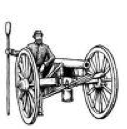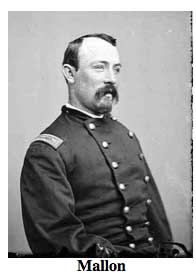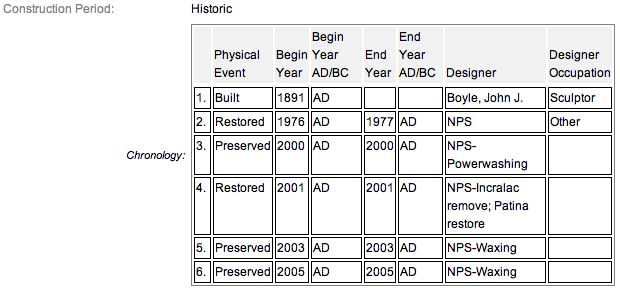
The 59th New York Infantry was also known as Union Guards. During the battle of Gettysburg, it served as a member of Harrow’s Brigade in Gibbon’s Division of the Second Corps, Army of the Potomac, a Fighting 300 Regiment. At Gettysburg, the 59th occupied a position on the right of Hall's line on Cemetery Ridge. There it fought on July 2 against the assault of Brig. Gen. Ambrose R. Wright. The 59th was present at the final assault on the Petersburg fortifications and was then stationed at Munson's Hill, Virginia, where it was mustered out on June 30, 1865, haying rendered such effective service to the Union cause as entitled it to rank among the "three hundred fighting regiments of the war." All totaled, the regiment lost 141 by death from wounds and 130 from accident, imprisonment or disease, of whom 64 died in Confederate prisons. The 59th New York Infantry is also honored with a  monument at the
monument at the  Antietam National Battlefield in Sharpsburg, Maryland.
Antietam National Battlefield in Sharpsburg, Maryland.
At Gettysburg, the 59th was commanded by Lieutenant Colonel Max A. Thoman (ca. 1830-1863). He was a liquor salesman in New York City. Thoman was nicknamed "Jack of Diamonds". He served in his native Germany during the 1848-1851 Schleswig-Holstein War and in William Walker's 1855 Filibuster Expedition to Central America. Upon the outbreak of the Civil War he was commissioned Captain and commander of Company A, 59th New York Volunteer Infantry (the "Union Guards"), and eventually rose to Lieutenant Colonel and commander of the unit. He was wounded at Antietam. During the second day of the Battle of Gettysburg, Pennsylvania (July 2, 1862) he was leading his troops in the repulse of the Confederate attack on Cemetery Ridge when an artillery shell fractured his right arm. He lingered in pain from this injury for nine days before dying on July 11. Before his succumbed to his wounds, he expressed his desire to be buried amongst his fallen men, and his wish was honored. He is one of the two highest ranking soldiers to be interred in the  Gettysburg National Cemetery. The regiment under Lieutenant Colonel Thoman brought 182 men to the field, and among them 6 men were killed and 28 were wounded.
Gettysburg National Cemetery. The regiment under Lieutenant Colonel Thoman brought 182 men to the field, and among them 6 men were killed and 28 were wounded.
The 59th New York Infantry Monument is located on the left or west side of  Hancock Avenue (RD310) if traveling north along the road at an area called The Angle. The monument is 191 feet from the road, resting in the grass, 215 feet southwest of the
Hancock Avenue (RD310) if traveling north along the road at an area called The Angle. The monument is 191 feet from the road, resting in the grass, 215 feet southwest of the  High Water Mark of the Rebellion Monument (MN230). On this side of the road there are about 1080 feet of green fields with a line of monumentation spread across it representing the line of union regiments who defended Cemetery Ridge at The Angle against Longstreet's assault also referred to as Pickett's Charge on July 3, 1863, the final day of the Great Battle.
High Water Mark of the Rebellion Monument (MN230). On this side of the road there are about 1080 feet of green fields with a line of monumentation spread across it representing the line of union regiments who defended Cemetery Ridge at The Angle against Longstreet's assault also referred to as Pickett's Charge on July 3, 1863, the final day of the Great Battle.  Parking is plentiful and is available road-side at intermittently enlarged shoulder cut-outs, usually marked with white striping. Be sure to keep vehicles off the grass or you will be ticketed by park police. I visited this monument on Tuesday, August 7, 2012 at approximately 4:30 P.M. I was at an elevation of 5601feet, ASL. I used a Canon PowerShot 14.1 Megapixel, SX210 IS digital camera for the photos.
Parking is plentiful and is available road-side at intermittently enlarged shoulder cut-outs, usually marked with white striping. Be sure to keep vehicles off the grass or you will be ticketed by park police. I visited this monument on Tuesday, August 7, 2012 at approximately 4:30 P.M. I was at an elevation of 5601feet, ASL. I used a Canon PowerShot 14.1 Megapixel, SX210 IS digital camera for the photos.
The Draw the Sword site helped out by the NPS narrative and the SIRIS site offers the following description: Granite marker with pyramidal cap contains reliefs of a Coat of Arms tondo, trophy with cartridge box, crossed bayonets and a laurel branch. Monument is a stepped, tapered granite shaft with a pyramidal top that has a bronze medallion on the peak and set on a 7.2×5.6 foot, two part base. The shaft has excised detail and polished inscriptions. Overall height is 11.8 feet. Flanking markers are one foot square.
The monument was dedicated in July 8, 1889 by the State of New York. The monument is composed of granite w/ bronze elements and has the following dimensions: The sculpture is 11 feet 8 inches x 7 feet 2 inches x 5 feet 6 inches. The monument was fabricated by Frederick & Field, artisans of countless monuments at Gettysburg. There are inscriptions on all four sides which read:
 (Front):59th
(Front):59th
New York
Infantry,
3d Brig. 2d Div.
2d Corps.
(Left):Commanders:
W.L. Tidball,
M.A. Thoman,
H.P. Rugg,
W.A. Olmstead.
(Back):Four companies
of this regiment
held this position
July 2 and 3 1863,
where Max A. Thoman,
Lieut. Colonel in command,
fell mortally wounded.
Casualties;
killed 6, wounded 28.
(Right):Mustered in
July 4, 1861.
Participated in
23 Engagements.
Mustered out
June 30, 1865.
The 59th New York Infantry Monument is a contributing feature to the Gettysburg National Military Park Historic District which is nationally significant under NR Criteria A, B, C & D. Areas of Significance: Military, Politics/Government, Landscape Architecture, Conservation, Archeology-Historic. Period of Significance: 1863-1938. The original National Register Nomination was approved by the Keeper March 19, 1975. An update to this nomination was approved by the Keeper on January 23, 2004. The monument is identified as structure number MN232-B.
From the Nomination Form:
1 of 90 monuments ot NY. Locates position held by 59TH NY July 2-3, 1863. Under attack both days & repulsed Confederate soldiers both times. Located on Cemetery Ridge W of Hancock Ave, SW of Copse of Trees. LF&RF 27'&75' to Mn, respectively.
Short Physical Description:
Mn & 2 flank markers. Base: 7'2"x5'6" of two parts. Shaft: stepped, tapered granite w/excised detail & polished inscriptions. Bronze medallion on peak, capped by pryamidal top. All 11'8" H. LF&RF marker 1'sq x1'5"H. Bronze accoutrements missing.
Long Physical Description:
Monument that has two flanking markers. Monument is a stepped, tapered granite shaft with a pyramidal top that has a bronze medallion on the peak and set on a 7.2x5.6 foot, two part base. The shaft has excised detail and polished inscriptions. Overall height is 11.8 feet. Flanking markers are one foot square. Located southwest of the Copse of Trees west of Hancock Avenue.

My Sources
1.
NRHP Nomination Form
2.
SIRIS
3.
Stone Sentinels
4.
Virtual Gettysburg
5.
Draw the Sword
6.
Historical Marker Database
7.
New York State Military Museum
8.
Wikipedia
9.
Find a Grave